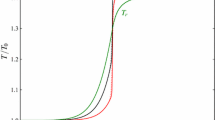Abstract
We study planar shock wave structure in a two-temperature model of a fully ionized plasma that includes electron heat conduction and energy exchange between electrons and ions. For steady flow in a reference frame moving with the shock, the model reduces to an autonomous system of ordinary differential equations which can be numerically integrated. A phase space analysis of the differential equations provides an additional insight into the structure of the solutions. For example, below a threshold Mach number, the model produces continuous solutions, while above another threshold Mach number, the solutions contain embedded hydrodynamic shocks. Between the threshold values, the appearance of embedded shocks depends on the electron diffusivity and the electron–ion coupling term. We also find that the ion temperature may achieve a maximum value between the upstream and downstream states and away from the embedded shock. We summarize the methodology for solving for two-temperature shocks and show results for several values of shock strength and plasma parameters in order to quantify the shock structure and explore the range of possible solutions. Such solutions may be used to verify hydrodynamic codes that use similar plasma physics models.
Similar content being viewed by others
References
Zel’dovich Y.B.: Shock waves of large amplitude in air. Sov. Phys. JETP 5, 919–927 (1957)
Shafranov V.D.: The structure of shock waves in a plasma. Sov. Phys. JETP 5, 1183–1188 (1957)
Imshennik V.S.: Shock wave structure in a hot, dense plasma. Sov. J. Plasma Phys. 1, 108–116 (1975)
Imshennik V.S.: Shock wave structure in a dense high-temperature plasma. Sov. Phys. JETP 15, 167–174 (1962)
Jaffrin M.Y., Probstein R.F.: Structure of a plasma shock wave. Phys. Fluids 7, 1658–1674 (1964)
Tidman D.A.: Structure of shock wave in fully ionized hydrogen. Phys. Rev 111, 1439–1446 (1958)
Bouquet S., Teyssier R., Chieze J.P.: Analytical study and structure of a stationary radiative shock. Astrophys. J. Suppl. Ser. 127, 245–252 (2000)
Drake R.P.: Theory of radiative shocks in optically thick media. Phys. Plasmas 14, 043301 (2007)
Lowrie R.B., Rauenzahn R.M.: Radiative shock solutions in the equilibrium-diffusion limit. Shock Waves 16, 445–453 (2007)
Lowrie R.B., Edwards J.D.: Radiative shock solutions with grey nonequilibrium diffusion. Shock Waves 18, 129–143 (2008)
Jukes J.D.: The structure of a shock wave in a fully ionized gas. J. Fluid Mech. 3, 275–285 (1957)
Vidal F., Matte J.P., Casanova M., Larroche O.: Ion kinetic simulations of the formation and propagation of a planar collisional shock wave in a plasma. Phys. Fluids B 5, 3182–3190 (1993)
Velikovich A.L., Whitney K.G., Thornhill J.W.: A role for electron viscosity in plasma shock heating. Phys. Plasmas 8, 4524–4533 (2001)
Lindl J.D.: Inertial Confinement Fusion. Springer, New York (1998)
Atzeni S., Meyer-Ter-Vehn J.: The Physics of Inertial Fusion. Oxford University Press, Oxford (2004)
Drake R.P.: High Energy Density Physics. Springer, Berlin (2006)
Zel’dovich Y.B., Raizer Y.P.: Physics of Shock Waves and High-Temperature Hydrodynamic Phenomena. Academic Press, New York (1967)
Mihalas D., Mihalas B.W.: Foundations of Radiation Hydrodynamics. Oxford University Press, New York (1984)
McClarren R.G., Wohlbier J.G.: Solutions for ion–electron–radiation coupling with radiation and electron diffusion. JQSRT 112, 119–130 (2011)
Gittings M., Weaver R., Clover M., Betlach T., Byrne N., Coker R., Dendy E., Hueckstaedt R., New K., Oakes W., Ranta D., Stefan R.: The RAGE Radiation-Hydrodynamic Code. Comput. Sci. Discov. 1, 015005 (2008)
Author information
Authors and Affiliations
Corresponding author
Additional information
Communicated by D. Zeitoun.
Rights and permissions
About this article
Cite this article
Masser, T.O., Wohlbier, J.G. & Lowrie, R.B. Shock wave structure for a fully ionized plasma. Shock Waves 21, 367–381 (2011). https://doi.org/10.1007/s00193-011-0313-3
Received:
Revised:
Accepted:
Published:
Issue Date:
DOI: https://doi.org/10.1007/s00193-011-0313-3




